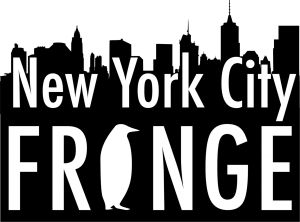
New York City Fringe (formally the FRIGID Fringe Festival) is an open, lottery-based theater festival that gives artists an opportunity to let their ingenuity thrive in an environment that values freedom of expression and artistic determination. In true support of the Indie Theater Community, 100% of box office proceeds go directly to the artists whose work is being presented.
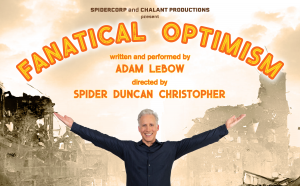
Fanatical Optimism
“Welcome to the land of debris and the home of decay”. The title of Adam LeBow’s extremely detailed rant Fanatical Optimism might seem incongruous with his material. Climate change, defense spending, AI, racism, cultural appropriation, “Ronald fucking Reagan”, corporate greed, religion and drag queens are some of the many hot buttons pressed. I would love to see this show taped and watched by families during holiday get togethers. Discussion would most certainly ensue.
For those with open eyes and ears, much of the territory covered will be sadly familiar. “Nukes are back!” America is consumed by the “same old tired imperial proxy war circus”. Our economy based on “vast profit accumulation and wage suppression” is labeled “inflation”. Revoking the Fairness Doctrine enabling broadcast media to stop presenting alternative points of view.
Artificial Intelligence is likened to the human race having bought the farm, sung Old MacDonald style: “AI, AI, oh”. The threat is our complacency. We are letting AI take all of our jobs. Cue Arnold Schwarzenegger jokes. The problem is dauntingly large. Mr. LeBow’s worries about “millions of unemployed people scared and pissed off in a country awash in guns”.
Midway through this tirade is a section where a long list of everything that’s worrisome is belched in an extraordinary summation. It made me ill but I wanted to have a copy of the list because it felt so complete. I have to say that I don’t necessary see all of the connections made and agree with every position taken (i.e., the influence of Gordon Gecko). That doesn’t matter. He ended a jaw dropping end-of-the-world list with “Beyoncé made a country album”. There is some funny in here to keep us from jumping off the bridge.
Fanatical Optimism looks inward as well. That strengthens the show and gives us all a chance to consider our individual arcs in conjunction with the changes around us. People born in the 1960s were the beneficiaries of social, political and cultural currents. Their soil was planted hearing songs which said “a child is black / a child is white / together they grow to see the light”. Today the Bible is used to “subjugate the threatening other”.
The material here is heavy stuff and points to the “rancid, reeking, sewage sludge we are all dealing with”. Mr. LeBow references “all the stuff I’ve talked about and what I haven’t”. What could possibly be missing? He does attempt to end these proceedings on a happy note so that his show won’t be called depressing and “be banished from the cultural landscape”.
Is there a path forward to address the “impotent rage of a dying aristocracy?” He asks “How much would we do to save the world?” We are people who “lose our shit when we can’t get Wi-Fi” so the disheartening conclusion is “probably not much”. This polemic is packed full of anger and told by a smiling Boomer/Gen X hybrid who wields a large smile and a heavy heart.
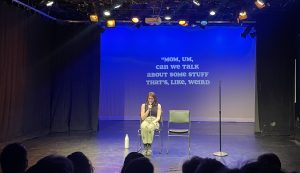
Joy Ride
A 2006 Toyota Sienna minivan with a “super high tech” six CD spinner is the setting for a family Joy Ride. Meredith Brandt’s one woman show recounts personal stories using song parodies from tunes she heard over and over again. Apparently the discs were “stuck” in the player so they were fully implanted in the brain.
The conceit is a winning one. A sleepover in first grade results in a desire to come home. “On My Own” from Les Misérables is rewritten as “Get Me Home”. The tone is light and the memories recalled are warmly presented.
A Barbra Streisand compilation Essential Babs provides the lyrical high point in this show. “Don’t Rain On My Parade is coopted while recounting her father’s driving. “Dad hits the gas vroom” made me laugh but the whole song is clever. Joy Ride is pleasant enough because the idea is soundly developed. Adding in a Bonus Track was inspired. Some funnier lyrics in all the song parodies would sharpen and enhance the joy in this sweetly concocted ride.
The New York City Fringe concluded its run on April 21, 2024. This blog reviewed fourteen of the nearly four dozen works staged.

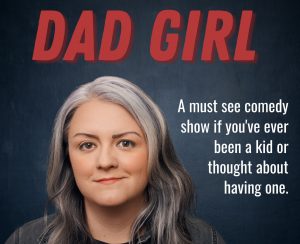
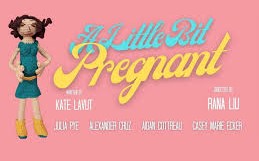
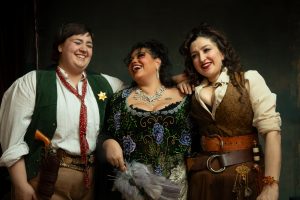

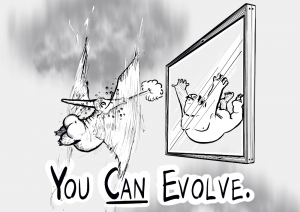


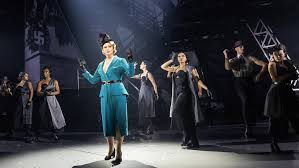


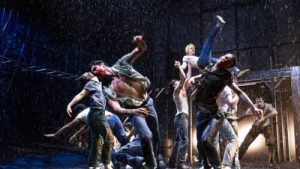

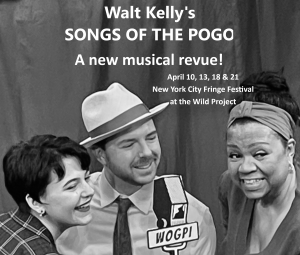
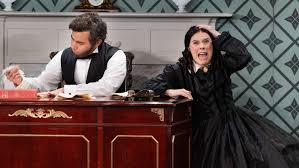
You must be logged in to post a comment.